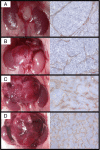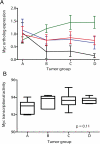Serial transcriptome analysis and cross-species integration identifies centromere-associated protein E as a novel neuroblastoma target
- PMID: 20233875
- PMCID: PMC2848992
- DOI: 10.1158/0008-5472.CAN-09-3844
Serial transcriptome analysis and cross-species integration identifies centromere-associated protein E as a novel neuroblastoma target
Abstract
Cancer genomic studies that rely on analysis of biopsies from primary tumors may not fully identify the molecular events associated with tumor progression. We hypothesized that characterizing the transcriptome during tumor progression in the TH-MYCN transgenic model would identify oncogenic drivers that would be targetable therapeutically. We quantified expression of 32,381 murine genes in nine hyperplastic ganglia harvested at three time points and four tumor cohorts of progressively larger size in mice homozygous for the TH-MYCN transgene. We found 93 genes that showed a linearly increasing or decreasing pattern of expression from the preneoplastic ganglia to end stage tumors. Cross-species integration identified 24 genes that were highly expressed in human MYCN-amplified neuroblastomas. The genes prioritized were not exclusively driven by increasing Myc transactivation or proliferative rate. We prioritized three targets [centromere-associated protein E (Cenpe), Gpr49, and inosine monophosphate dehydrogenase type II] with previously determined roles in cancer. Using siRNA knockdown in human neuroblastoma cell lines, we further prioritized CENPE due to inhibition of cellular proliferation. Targeting CENPE with the small molecular inhibitor GSK923295 showed inhibition of in vitro proliferation of 19 neuroblastoma cell lines (median IC(50), 41 nmol/L; range, 27-266 nmol/L) and delayed tumor growth in three xenograft models (P values ranged from P < 0.0001 to P = 0.018). We provide preclinical validation that serial transcriptome analysis of a transgenic mouse model followed by cross-species integration is a useful method to identify therapeutic targets and identify CENPE as a novel therapeutic candidate in neuroblastoma.
Figures






References
-
- Maris JM, Hogarty MD, Bagatell R, Cohn SL. Neuroblastoma. Lancet. 2007;369:2106–20. - PubMed
-
- Matthay KK, Villablanca JG, Seeger RC, et al. Treatment of high-risk neuroblastoma with intensive chemotherapy, radiotherapy, autologous bone marrow transplantation, and 13-cis-retinoic acid. Children's Cancer Group. New England Journal of Medicine. 1999;341:1165–73. - PubMed
-
- Berthold F, Boos J, Burdach S, et al. Myeloablative megatherapy with autologous stem-cell rescue versus oral maintenance chemotherapy as consolidation treatment in patients with high-risk neuroblastoma: a randomised controlled trial. Lancet Oncol. 2005;6:649–58. - PubMed
-
- Oeffinger KC, Mertens AC, Sklar CA, et al. Chronic health conditions in adult survivors of childhood cancer. N Engl J Med. 2006;355:1572–82. - PubMed
Publication types
MeSH terms
Substances
Grants and funding
LinkOut - more resources
Full Text Sources
Medical
Molecular Biology Databases

